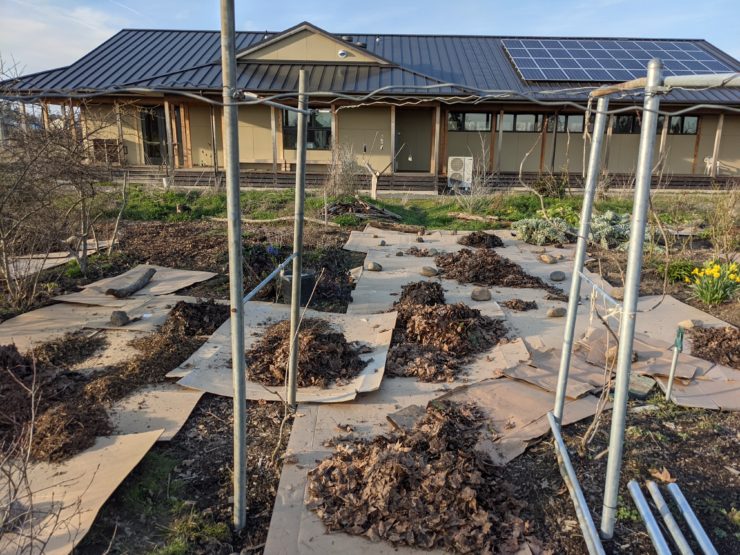Virtual Spring Garden Tour
written by Gabe Penk, Gardenmaster
The land around Dharma Rain is always full of life, but this time of year it is particularly evident. If you have not been in-person recently, it is an ideal time to walk the various trails, pay regards to the chickens, or sit and enjoy the flowers in the garden. Treat this post as either a virtual tour or inspiration for a future visit!

As you begin your walk from the south entrance of the Sodo, you pass a small native wildflower meadow where blue camas lilies are blooming along with pink spires of checker mallow, drooping yellow and red columbine, and blue lupine. In a few locations you can find the strange yellow tufts of bare-stem desert parsley flowers amongst the tall grasses. Many of these plants have been cultivated and cared for by Indigenous communities since time immemorial and remind us that we are on Native land, in particular, the homeland of the Clackamas, Multnomah, and Cascade bands of Chinook people.

The garden area immediately south of the Sodo has seen a lot of attention this winter and spring and now has a new network of wood chip pathways leading to several gathering spaces. Starting last fall, volunteers helped remove the raised beds and spread sheets of cardboard and a prodigious amount of leaves (from the grounds of nearby Portland schools) in order to suppress weeds and create new beds for planting this coming fall. Several young fruit trees were welcomed into the garden which already hosts a range of edible plants such as aronia, goji berry, seaberry, asparagus, rhubarb, wine cap mushroom, artichoke, kiwi, and a variety of herbs. Many volunteers have contributed to this design project including generous help by youth from the Blueprint Foundation. The garden has also appreciated help from Daoren members, the Meetup group Do Zen, as well as members from Municipal Eco-Resiliency Project.

In the beds above the orchard and east of the founder’s shrine, this year’s vegetable crops are taking root. A lush mix of oats and peas have supported the soil through the winter and are being composted to make way for transplants of broccoli, lettuce, cabbage, brussels sprouts, kale, potatoes, leeks, and annual flowers. The garlic planted last fall endured the winter well and is beginning to form its tasty cloves. Tomatoes, basil, peppers, and eggplant are still staying warm in their trays in the greenhouse by the barn, currently shared with two baby ducks.

Also next to the barn, the chickens continue to appreciate the attention from neighbors and families who visit regularly and sometimes stay for a picnic in the grass nearby. Students from nearby McDaniel High School’s sustainable agriculture program have been tending several of the raised beds around the barn. Several community members also take care of their own beds.
A walk along the gravel path into the orchard reveals the prolific blooms of hawthorn as well as a few young medlar and quince trees. The pear, apple, plum, apricot, and cherry have already bloomed and are forming fruit. This spring, I experimented with grafting pear onto hawthorn root stock in hopes of taking advantage of the vigorous, though invasive, hawthorn already flourishing in this area. Almost two months after joining the small pear cuttings to freshly cut branches of hawthorn, most of the pear have budded out and appear to be growing well. The graft where the two are joined appears to be healing, all promising signs.
Nestled in the orchard below the chickens are three active honeybee hives; the one that survived the winter has been split into two colonies, and a community member is taking care of a third. They join the various bumblebees and solitary bees who also make their home at Dharma Rain, keeping the flowers company and helping pollinate our garden fruit including the strawberries and raspberries just starting to bloom.

Continuing down through the orchard the trail turns north into the ravine now shaded by maple and plum, passes by a small seasonal pond, and eventually winds back up to the main entrance from Siskiyou street. If you live locally, I encourage you to come visit for an evening walk, or bring a lunch to eat outside after Sunday service. Another way to connect with the land and gardens at Dharma Rain is through volunteering. We currently hold work parties most Wednesdays from about 9 to mid-afternoon, and also on Saturday afternoons in which all are welcome and encouraged to attend regardless of gardening experience. Check the calendar in advance for more details or contact Dharma Rain at . Thanks to all who have contributed to this place either through volunteering or simply stopping by to rest or converse with the chickens. Hope to see you soon!
